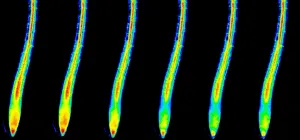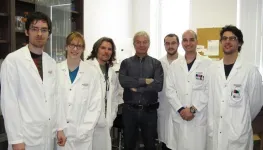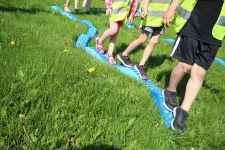(Press-News.org) Russian scientists have proposed a new algorithm for automatic decoding and interpreting the decoder weights, which can be used both in brain-computer interfaces and in fundamental research. The results of the study were published in the Journal of Neural Engineering.
Brain-computer interfaces are needed to create robotic prostheses and neuroimplants, rehabilitation simulators, and devices that can be controlled by the power of thought. These devices help people who have suffered a stroke or physical injury to move (in the case of a robotic chair or prostheses), communicate, use a computer, and operate household appliances. In addition, in combination with machine learning methods, neural interfaces help researchers understand how the human brain works.
Most frequently brain-computer interfaces use electrical activity of neurons, measured, for example, with electro- or magnetoencephalography. However, a special decoder is needed in order to translate neuronal signals into commands. Traditional methods of signal processing require painstaking work on identifying informative features--signal characteristics that, from a researcher's point of view, appear to be most important for the decoding task.
Initially, the authors focused on electrocorticography (ECoG) data--an invasive recording of neural activity with electrodes located directly on the cortical surface under the dura mater, a shell that encapsulates brain, -- and developed an artificial neural network architecture that automates the extraction of interpretable features.
As conceived by the scientists, the neural network algorithm should not be too complicated in terms of the number of parameters. It should be automatically tuned and enable one to interpret the learned parameters in physiologically meaningful terms. The last requirement is especially important: if it is met, the neural network can be used not only to decode signals, but also to gain new insights into the neuronal mechanisms, the dream come true for neuroscientists and neurologists. Therefore, in addition to a new neural network for signal processing, the authors proposed (and theoretically justified) a method for interpreting the parameters of the broad class of neural networks.
The neural network proposed by the researchers consists of several similarly structured branches, each of which is automatically tuned to analyze the signals of a separate neural population in a certain frequency range and is tuned away from interference. To do this, they use convolutional layers similar to those that comprise neural networks, sharpened for image analysis, and which act as spatial and frequency filters. Knowing the weights of the spatial filter, it is possible to determine where the neural population is located, and the temporal convolution weights show how the neuron activity changes over time in addition to indirectly indicating the neuronal population size.
To assess the performance of their neural network in combination with a new method for interpreting its parameters, the scientists first generated a set of realistic model data, or 20 minutes of activity from 44 neuron populations. Noise was added to the data to simulate interference when recording signals in real conditions. The second set of data to check was a dataset from the BCI Competition IV, containing the ECoG data of several subjects who periodically moved their fingers spontaneously. Another set of ECoG data was collected by the scientists themselves at the Moscow State University of Medicine and Dentistry, which serves as the clinical base of the Centre for Bioelectric Interfaces of HSE University. Unlike previous data, the records collected by the scientists contained complete geometric information about the location of the ECoG electrodes on the surface of each patient's cerebral cortex. This made it possible to interpret the weights of the spatial filters learned by the neural network and to discern somatotopy (i.e., the relationship between the neural population's position on the cerebral cortex and the body part it functionally corresponds to) in the location of the neuron populations pivotal for decoding the movement of each finger.
The neural network performed nicely: with the BCI Competition IV dataset, it worked on par with the solution proposed by the competition winners, but, unlike the solution, it used automatically selected features. While working with both real and model data, the researchers proved that it is possible to interpret the scale parameters correctly and in detail, and the interpretation gives physiologically plausible results. The researchers also applied a new technique to the classification of imaginary movements based on non-invasive (obtained from the surface of the head, without implanting electrodes) EEG data. As in the case of ECoG, the neural network provided high decoding accuracy and feature interpretability.
'We are already using this approach to build invasive brain-computer interfaces, as well as to solve issues of preoperative cortex mapping, which is necessary to ensure that key behavioral functions are preserved after brain surgery', says the scientific lead of the study and the director of the HSE Center for Bioelectric Interfaces, Alexei Ossadcthi. 'In the nearest future, the developed technique will be used to automatically extract knowledge about the principles according to which the brain implements a broad range of behavioral functions.'
INFORMATION:
The study involved researchers of the Centre for Bioelectrical Interfaces of HSE University and the Moscow State University of Medicine and Dentistry
In the hours after we die, certain cells in the human brain are still active. Some cells even increase their activity and grow to gargantuan proportions, according to new research from the University of Illinois Chicago.
In a newly published study in the journal Scientific Reports, the UIC researchers analyzed gene expression in fresh brain tissue -- which was collected during routine brain surgery -- at multiple times after removal to simulate the post-mortem interval and death. They found that gene expression in some cells actually increased after death.
These 'zombie genes' -- those that increased expression after the post-mortem interval -- were specific to one type of cell: inflammatory cells called ...
Potassium is an essential nutrient for all living things. Plants need it in large quantities, especially for growth and in order to withstand stress better. For this reason, they absorb large quantities of potassium from the soil. In agriculture, this leads to a lack of available potassium in the soil - which is why the mineral is an important component in fertilizers. A team of German and Chinese researchers has now shown, for the first time, where and how plants detect potassium deficiency in their roots, and which signalling pathways coordinate the adaptation of root growth and potassium absorption ...
A number of studies have shown that human coronaviruses, including SARS-CoV-2 which causes COVID-19, appear to attack neurons and the nervous system in vulnerable populations. This neuroinvasion through the nasal cavity leads to the risk of neurological disorders in affected individuals. Research conducted at the Institut national de la recherche scientifique (INRS) has identified ways to prevent the spread of infection within the central nervous system (CNS). The study, led by Professor Pierre Talbot and his research associate Marc Desforges, now at CHU-Sainte-Justine, ...
According to a recent Finnish study, accumulating more brisk and vigorous physical activity can curb adiposity-induced low-grade inflammation. The study also reported that diet quality had no independent association with low-grade inflammation. The findings, based on the ongoing Physical Activity and Nutrition in Children (PANIC) Study conducted at the University of Eastern Finland, were published in the European Journal of Sport Science.
The study was made in collaboration among researchers from the University of Jyväskylä, the University of Eastern Finland, the Norwegian School of Sport Sciences, and the University of Cambridge.
Low-grade inflammation is linked to many chronic diseases, but exercise can ...
Casual sex is on the decline for both young men and women, according to a Rutgers University-New Brunswick study that found less alcohol consumption among both genders is a major reason while playing video games and living at home with parents are another--but only for men.
The study, published in the journal Socius, found that between 2007 and 2017, the percentage of 18-to 23-year-old men who had casual sex in the past month dropped from 38 percent to 24 percent. The percentage dropped from 31 percent to 22 percent for young women of the same age.
The most important factor driving the decline among young men is the decrease in drinking, which alone explains more than ...
The vast reservoir of carbon that is stored in soils probably is more sensitive to destabilization from climate change than has previously been assumed, according to a new study by researchers at WHOI and other institutions.
The study found that the biospheric carbon turnover within river basins is vulnerable to future temperature and precipitation perturbations from a changing climate.
Although many earlier, and fairly localized, studies have hinted at soil organic carbon sensitivity to climate change, the new research sampled 36 rivers from around the ...
As the pandemic's economic effects drive more people to enroll in Medicaid as safety-net health insurance, a new study suggests that the program's dental coverage can improve their oral health in ways that help them seek a new job or do better at the one they have.
The study focuses on the impact of dental coverage offered through Michigan's Medicaid expansion, called the Healthy Michigan Plan. The researchers, from the University of Michigan, used a survey and interviews to assess the impact of this coverage on the health and lives of low-income people who enrolled.
In all, 60% of the 4,090 enrollees surveyed for the new study had visited a dentist at least once since enrolling ...
Daily national surveys by Carnegie Mellon University show that while COVID-19 vaccine uptake has increased, the proportion of vaccine-hesitant adults has remained unchanged. The concerns about a side effect remain high, especially among females, Black adults and those with an eligible health condition.
The Delphi Research Group at CMU in partnership with Facebook released its latest survey findings. The analyses show that vaccine hesitancy persists and point to potential tactics to combat it.
"Prior research by the CDC has found that Black and Hispanic adults are the least likely to receive the annual flu vaccine each year," said Alex Reinhart, assistant teaching professor in CMU's Department of Statistics & Data Science and a member of the Delphi ...
It can be hard to resist lapsing into an exaggerated, singsong tone when you talk to a cute baby. And that's with good reason. Babies will pay more attention to baby talk than regular speech, regardless of which languages they're used to hearing, according to a study by UCLA's Language Acquisition Lab and 16 other labs around the globe.
The study found that babies who were exposed to two languages had a greater interest in infant-directed speech -- that is, an adult speaking baby talk -- than adult-directed speech. Research has already shown that monolingual babies prefer baby talk.
Some parents worry that teaching two languages could mean an infant won't learn to speak on time, but the new study shows bilingual babies are developmentally right ...
In Slovakia, in counties subject to two rounds of rapid antigen testing for SARS-CoV-2 where those who tested positive then isolated, the approach helped decrease the prevalence of positive tests by more than 50% in a week - all while primary schools and workplaces remained open. "While it was impossible to disentangle the precise contribution of control measures and mass testing," the authors said, mass testing is likely to have had a substantial effect, their modeling showed. Applying mass testing may provide a valuable tool in future containment of SARS-CoV-2 elsewhere, they say. ...





